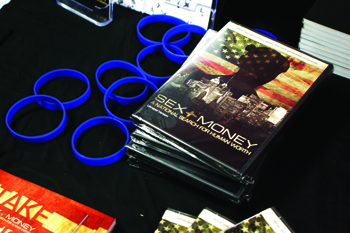Sex and Money: Film brings awareness of trafficking in America

Editor’s note: This story has been edited from its original version.
Sex. Money.
Two words that should have nothing to do with each other, but for millions of people in today’s society, have become entwined.
The gigantic bus parked outside of DeMoss on Monday, Aug. 5, with these two words splashed across it may have confused onlookers, but inside, a group of five recent college graduates were planning and praying as they sought to bring awareness of child sex trafficking to another city on their 50 state tour with their documentary, Sex and Money.
According to the film, sex trafficking is the second largest criminal industry in the world. While awareness of global sex trafficking has increased, many Americans are unaware that it is happening in their own backyards.
“We have an acute awareness of trafficking happening in places like Asia or Eastern Europe and nobody thinks that slavery is happening in the United States or in their city, in their suburb or in their small town,” the film said.
“The only way not to find this problem in any city is simply not to look for it,” Ernie Allen, president of the National Center for Exploited and Missing Children, said in the film.
Freshman Jillian Floyd said she was shocked at how severe the problem of sex trafficking was in America.
“I knew that it went on a little bit, but I had no idea that the numbers were so significant. It’s really convicting to know that that’s going on and you have no idea about it,” Floyd said.
The numbers truly were hard to ignore. According to the film, approximately 100 thousand children are victims of child prostitution and child trafficking each year. That’s the equivalent of the Vines Center filled to its maximum capacity 10 times. The average age when children enter into child prostitution or trafficking is 12 to 14.
Many of these victims are runaways who are trying to escape broken homes full of abuse, violence and, more times than not, sexual abuse. The film dissects how the victims’ home situation has usually warped the mindset of the victim, making them believe that their validity comes from men and that their identity and worth lies in their sexuality.
“It was just heartbreaking to see how these women viewed themselves when God sees them in such a beautiful and amazing way. It’s sad to see how they need men to see them a certain way to have self worth when all their worth is (really) found in Christ,” sophomore Elizabeth Chadwick said.
Unfortunately, these young women run straight into the hands of people who all too willingly take advantage of them and make a profit doing so. And, according to the film, society’s common image of a pimp, or someone who picks up a prostitute, is very off. The film states that the buyer includes all types of people. Ninety-five percent of buyers are married men and 75 percent are white. The fact that the buyer could include anyone from doctors to construction workers to teachers to pastors was the most shocking part of the film for sophomore Sarah Mae Hines.
“I was surprised to know that a lot of average people partake in it. It’s not just gangs, but lawyers, pastors and a lot of people struggle with that sin,” Hines said.
However, the film did not place the blame solely on the buyers. The team of filmmakers explored the root cause of the issue, exploring the role that the pornography industry and the sexualization of America has had on sex trafficking and child prostitution. The documentary points out how in today’s mainstream media, the word pimp is carelessly thrown around in shows such as ‘Pimp My Ride’ and songs such as Jay Z’s ‘Big Pimpin.’ A former child prostitute points out how the movie ‘Pretty Woman’ glamorized the lifestyle of a prostitute for her and had a big influence on her decision to run away and become a prostitute.
“(But) it’s not reality. It’s not showing behind the scenes,” the woman said.
The documentary ended with how people could take action and stop the horrific acts of child trafficking and prostitution. Sex and Money pointed out that what really needed to happen was a cultural shift and a change in the sexual mindset so pervading American society today.
The night ended with a time of prayer and worship, as students came forward to respond to what they had just seen.
Law student Tony Stimson spent months organizing the Sex and Money screening and said that for him, this was the most memorable part of the evening.
“God moved so powerfully, bringing healing to many who had a past of sexual abuse, delivering people from addictions, and healing scars. It was a beautiful time of God’s people crying out to Him and He was responding,” Stimson said.
For more information about the film or to find out how you can be involved in the fight against sex trafficking, check out www.sexandmoneyfilm.com . Also, check out Liberty’s new ministry, Beauty for Ashes, which will seek to help women involved in the sex industry.

